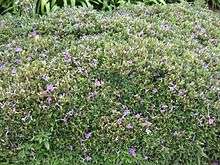Ruellia
Ruellia is a genus of flowering plants commonly known as ruellias or wild petunias.[3] They are not closely related to petunias (Petunia) although both genera belong to the same euasterid clade. The genus was named in honor of Jean Ruelle, herbalist and physician to Francis I of France and translator of several works of Dioscorides.
| Ruellia | |
|---|---|
 | |
| Ruellia tuberosa | |
| Scientific classification | |
| Kingdom: | Plantae |
| Clade: | Tracheophytes |
| Clade: | Angiosperms |
| Clade: | Eudicots |
| Clade: | Asterids |
| Order: | Lamiales |
| Family: | Acanthaceae |
| Subfamily: | Acanthoideae |
| Tribe: | Ruellieae |
| Genus: | Ruellia L.[1] |
| Species | |
|
Many, see text | |
| Synonyms[2] | |
|
List
| |
Apart from the numerous formerly independent genera nowadays considered synonymous with Ruellia, the segregate genera Blechum, Eusiphon, Polylychnis and Ulleria are often included in Ruellia. Acanthopale, however, is considered a distinct genus.
Ruellias are popular ornamental plants. Some are used as medicinal plants, but many are known or suspected to be poisonous. Their leaves are food for the caterpillars of several Lepidoptera (butterflies and moths), typically Nymphalinae and in particular members of their tribe Junoniini, such as the larvae of the banded peacock (Anartia fatima). Nymphalinae using Ruellia as host plants include the common buckeye (Junonia coenia), recorded on R. nodiflora, the lemon pansy (Junonia lemonias), recorded on R. tuberosa, and the malachite butterfly (Siproeta stelenes) and Australian lurcher (Yoma sabina), which are recorded on several species.

_in_Talakona_forest%2C_AP_W_IMG_8317.jpg)

Selected species
- Ruellia acutangula
- Ruellia affinis (Schrad.) Lindau
- Ruellia angustior
- Ruellia asperula
- Ruellia blumei Steud.
- Ruellia bourgaei Hemsl.
- Ruellia brevicaulis
- Ruellia brevifolia (Pohl) C.Ezcurra – tropical wild petunia, red Christmas pride
- Ruellia capitata
- Ruellia caroliniensis (J.F.Gmel.) Steud.
- Ruellia cernua Roxb.
- Ruellia chartacea (T.Anderson) Wassh.
- Ruellia ciliatiflora Hook.
- Ruellia ciliosa Pursh[4]
- Ruellia colorata (might belong in R. trivialis)
- Ruellia currorii
- Ruellia densa
- Ruellia devosiana Jacob-Makoy ex E.Morren
- Ruellia dielsii
- Ruellia diffusa
- Ruellia dioscoridis
- Ruellia dissitifolia
- Ruellia drymophila Hand.-Mazz.
- Ruellia elegans Poir.
- Ruellia eriocalyx
- Ruellia eurycodon
- Ruellia flava
- Ruellia formosa
- Ruellia fulgida Andrews
- Ruellia geminiflora – ipecacuanha-da-flor-roxa (Portuguese)
- Ruellia glanduloso-punctata
- Ruellia hapalotricha
- Ruellia helianthemum
- Ruellia humilis Nutt. – fringeleaf wild petunia, plains petunia, fringeleaf ruellia, hairy ruellia, low ruellia, zigzag ruel
- Ruellia hypericoides
- Ruellia incomta
- Ruellia insignis
- Ruellia jaliscana Standl.
- Ruellia macrantha (Nees) Gower – Christmas pride
- Ruellia kuriensis
- Ruellia macrantha (Nees) Gower – Christmas pride
- Ruellia macrophylla Vahl
- Ruellia makoyana Hort.Makoy ex Closon
- Ruellia mcvaughii T.F. Daniel
- Ruellia menthoides
- Ruellia neesiana
- Ruellia nitens
- Ruellia noctiflora
- Ruellia novogaliciana T.F. Daniel
- Ruellia nudiflora (Engelm. & A.Gray) Urb.
- Ruellia patula
- Ruellia paulayana
- Ruellia pedunculata
- Ruellia pohlii
- Ruellia portellae (might belong in R. trivialis)
- Ruellia prostrata Poir.
- Ruellia puri
- Ruellia rasa
- Ruellia rosea (Nees) Hemsl.
- Ruellia rufipila
- Ruellia salicifolia
- Ruellia simplex C.Wright
- Ruellia sindica
- Ruellia spissa Leonard
- Ruellia squarrosa (Fenzl) Cufod.
- Ruellia stemonacanthoides (Oerst.) Hemsl.
- Ruellia stenandrium
- Ruellia strepens L. (might belong in R. trivialis)
- Ruellia tomentosa
- Ruellia trachyphylla
- Ruellia trivialis
- Ruellia tuberosa L. – minnie root, fever root, snapdragon root, sheep potato, popping pod, duppy gun, cracker plant (syn. R. picta)
- Ruellia verbasciformis
- Ruellia villosa
- Ruellia vindex
- Ruellia zeylanica[3][5]
Formerly placed here
Numerous plants, mainly in the family Acanthaceae, are former members of Ruellia. Some examples are:
- Asystasia gangetica subsp. micrantha (Nees) Ensermu (as R. intrusa Forssk.)
- Asystasia gangetica subsp. gangetica (as R. zeylanica J.Koenig ex Roxb.)
- Blepharis ciliaris (L.) B.L.Burtt (as R. ciliaris L. or R. persica Burm.f.)
- Dyschoriste oblongifolia (Michx.) Kuntze (as R. oblongifolia Michx.)
- Hemigraphis repanda (L.) Hallier f. (as R. repanda L.)
- Hygrophila costata Nees et al. (as R. brasiliensis Spreng.)
- Hygrophila difformis (L.f.) Blume (as R. difformis L. f.)
- Hygrophila lacustris (Schltdl. & Cham.) Nees (as R. lacustris Schltdl. & Cham.)
- Hygrophila ringens (L.) R. Br. ex Steud. (as R. ringens L. or R. salicifolia Vahl)
- Lepidagathis alopecuroidea (Vahl) R. Br. ex Griseb. (as R. alopecuroidea Vahl)
- Lindernia antipoda (L.) Alston (as R. antipoda L.)
- Stenandrium dulce (Cav.) Nees (as R. dulcis Cav.)
- Strobilanthes anisophylla (Lodd. et al.) T. Anderson (as R. anisophylla Lodd. et al.)
- Strobilanthes hamiltoniana (Steud.) Bosser & Heine (as R. hamiltoniana Steud.)[5]
- Teliostachya alopecuroidea Nees (as R. alopecuroidea, R. alopecuroides)
See also
- 21540 Itthipanyanan, an asteroid named after a student who authored an award-winning experiment[6] on the dehiscence and dispersion of Ruellia tuberosa seed pods.
References
- "Genus: Ruellia L." Germplasm Resources Information Network. United States Department of Agriculture. 2009-01-23. Retrieved 2010-05-26.
- "Ruellia Plum. ex L." Plants of the World Online. Board of Trustees of the Royal Botanic Gardens, Kew. 2017. Retrieved 13 August 2020.
- "Ruellia". Integrated Taxonomic Information System. Retrieved 2011-05-20.
- "Ruellia ciliosa Pursh". Integrated Taxonomic Information System (ITIS). Retrieved 6 April 2013.
- "GRIN Species Records of Ruellia". Germplasm Resources Information Network. United States Department of Agriculture. Retrieved 2011-05-20.
- "21540 Itthipanyanan (1998 QE11)". JPL Small-Body Database. Jet Propulsion Laboratory. Retrieved 6 April 2013.
External links
| Wikimedia Commons has media related to Ruellia. |
| Wikispecies has information related to Ruellia |
| Wikisource has the text of the 1920 Encyclopedia Americana article Ruellia. |
- Germplasm Resources Information Network: Copioglossa
- PlantSystematics: Ruellia
- Classification: Ruellia, species list at USDA Natural Resources Conservation Service
- Tree of Life: Ruellia.